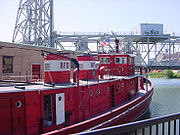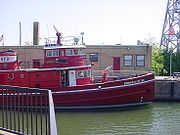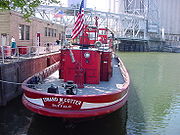.gif)
Edward M. Cotter (fire boat)
Encyclopedia
Edward M. Cotter is a fireboat
Fireboat
A fireboat is a specialized watercraft and with pumps and nozzles designed for fighting shoreline and shipboard fires. The first fireboats, dating to the late 18th century, were tugboats, retrofitted with firefighting equipment....
in use by the Buffalo Fire Department
Buffalo Fire Department
The Buffalo Fire Department is the principal fire and rescue service for the city of Buffalo, New York. It is the largest fire department in Upstate New York. The Fire Department currently consists of one division which is separated into four battalions, and further separated into 4 platoons...
at Buffalo, New York
Buffalo, New York
Buffalo is the second most populous city in the state of New York, after New York City. Located in Western New York on the eastern shores of Lake Erie and at the head of the Niagara River across from Fort Erie, Ontario, Buffalo is the seat of Erie County and the principal city of the...
, United States. The original name of the ship was the William S. Grattan, and she was built in 1900 by the Crescent Shipyard
Crescent Shipyard
Crescent Shipyard, located in Elizabeth, New Jersey, built a number of ships for the United States Navy and allied nations as well during their production run, which lasted about ten years while under the Crescent name and banner. Production of these ships began before the Spanish-American war and...
of Elizabeth Port, New Jersey. Due to age she was rebuilt in 1953 and was renamed Firefighter upon her return. The following year she was renamed the Edward M. Cotter. Her namesake, Edward Cotter, was a Buffalo firefighter and leader of the local firefighters union who had recently died.
The Edward M. Cotter is considered to be the oldest active fireboat in the world and was designated a National Historic Landmark in 1996.
Along with her firefighting duties, during the winter the Edward M. Cotter is used as an icebreaker
Icebreaker
An icebreaker is a special-purpose ship or boat designed to move and navigate through ice-covered waters. Although the term usually refers to ice-breaking ships, it may also refer to smaller vessels .For a ship to be considered an icebreaker, it requires three traits most...
on Buffalo's rivers. The Cotter mounts five fire monitors that are capable of pumping 15000 USgal/min. She can often be seen sailing out of her berth and south-west to Lake Erie, returning north through the breakwall and firing her fire monitors.
Construction
The ship that was to become the Edward M. Cotter was built in 1900 by the Crescent Shipyard of Elizabeth Port, New Jersey. She was originally named the William S. Grattan after the first paid fire commissioner for the city of Buffalo. Construction was started on March 24, 1900 and she was christenedShip naming and launching
The ceremonies involved in naming and launching naval ships are based in traditions thousands of years old.-Methods of launch:There are three principal methods of conveying a new ship from building site to water, only two of which are called "launching." The oldest, most familiar, and most widely...
on September 5, 1900 by Virginia Pearson, the young daughter of one of the city's fire commissioners. The final construction cost for the ship was $91,000.
The completed ship was 118 ft (36 m) in length, a beam
Beam (nautical)
The beam of a ship is its width at the widest point. Generally speaking, the wider the beam of a ship , the more initial stability it has, at expense of reserve stability in the event of a capsize, where more energy is required to right the vessel from its inverted position...
of 24 ft (7.3 m) and a draft
Draft (hull)
The draft of a ship's hull is the vertical distance between the waterline and the bottom of the hull , with the thickness of the hull included; in the case of not being included the draft outline would be obtained...
of 10 in 10 in (3.3 m). A 1.5 in (38.1 mm) thick belt line of Swedish steel was included around the hull for icebreaking duties. The Grattan was powered by two Babcock & Wilcox coal-fired boilers with steam engines rated at 900 hp. A single propeller
Propeller
A propeller is a type of fan that transmits power by converting rotational motion into thrust. A pressure difference is produced between the forward and rear surfaces of the airfoil-shaped blade, and a fluid is accelerated behind the blade. Propeller dynamics can be modeled by both Bernoulli's...
provided propulsion. The rated speed of the ship was 13 knots (7 m/s).
The ship was also equipped with three double action steam pumps that supplied water at 9,000 gallons per minute to the three fire monitors used for firefighting. Two of the fire monitors were mounted on the forward section of the ship and one was on the stern
Stern
The stern is the rear or aft-most part of a ship or boat, technically defined as the area built up over the sternpost, extending upwards from the counter rail to the taffrail. The stern lies opposite of the bow, the foremost part of a ship. Originally, the term only referred to the aft port section...
section.
History
At the beginning of the twentieth century, Buffalo's waterfront was an extremely busy center of commerce. Grain elevators, warehouses and shipping traffic had overtaxed the two existing fireboats: the John T. Hutchinson (Engine 23) and the George R. Potter (Engine 29). Also, the city of Buffalo had shoreline hookups to allow the fireboats to serve as floating pumping stations supplying high pressure water to a fire hydrantFire hydrant
A fire hydrant , is an active fire protection measure, and a source of water provided in most urban, suburban and rural areas with municipal water service to enable firefighters to tap into the municipal water...
system that covered the downtown area. The decision was made by city officials to order a third boat that would also have icebreaking capability along with her normal firefighting duties.

Lake Ontario
Lake Ontario is one of the five Great Lakes of North America. It is bounded on the north and southwest by the Canadian province of Ontario, and on the south by the American state of New York. Ontario, Canada's most populous province, was named for the lake. In the Wyandot language, ontarío means...
, through the Welland Canal
Welland Canal
The Welland Canal is a ship canal in Canada that extends from Port Weller, Ontario, on Lake Ontario, to Port Colborne, Ontario, on Lake Erie. As a part of the St...
and finally across Lake Erie
Lake Erie
Lake Erie is the fourth largest lake of the five Great Lakes in North America, and the tenth largest globally. It is the southernmost, shallowest, and smallest by volume of the Great Lakes and therefore also has the shortest average water residence time. It is bounded on the north by the...
in an uneventful trip that took 14 days. She was met 3 miles (4.8 km) out of the harbor by her sister fireboats and escorted in.
1928 fire
On July 28, 1928 the Grattan responded to the oil barge James F. Cahill, loaded with 5,000 barrels of crude oil, that was aflame. After burning 17 hours, the barge's mooring lines gave way and the barge began to drift. The Grattans crew attempted to attach tow lines to the drifting barge but it struck a dock at an oil company where the empty oil tankerOil tanker
An oil tanker, also known as a petroleum tanker, is a merchant ship designed for the bulk transport of oil. There are two basic types of oil tankers: the crude tanker and the product tanker. Crude tankers move large quantities of unrefined crude oil from its point of extraction to refineries...
B.B. McColl was moored. The fumes on the McColl ignited causing an explosion and fire that engulfed the Grattan. Captain Thomas Hylant along with his crew abandoned ship and swam through the flames to shore. Chief Engineer Thomas Lynch of the Grattan lost his life and seven other crew members were injured. The unattended boilers on the Grattan soon ran dry and exploded, leaving the ship burned out and heavily damaged.
The Grattan sat boarded up for eighteen months while city and fire department officials decided whether to replace her at a cost of $225,000 dollars or rebuild her for $99,000 dollars, which was $8,000 dollars more than her original cost. The decision was made to rebuild and in 1930 she was rebuilt at the Buffalo Dry Dock Company of Buffalo, New York. During this refit some improvements were made to the Grattan. One improvement was that her boilers were converted from burning coal to burning oil. The engines were rebuilt and her firefighting system was updated and could now handle foam
Fire retardant
A fire retardant is a substance other than water that reduces flammability of fuels or delays their combustion. This typically refers to chemical retardants but may also include substances that work by physical action, such as cooling the fuels; examples of these include fire-fighting foams and...
. Also, the pilot house was raised to the upper boat deck level and a fixed turret tower with a fire monitor was constructed on the stern of the ship. A fourth fire monitor was added to the top of the pilot house of the ship as well. As part of her acceptance ceremony she was recommissioned and participated in a race against the harbor tug Kentucky, which was considered to be one of the fastest tugs on the lakes
Great Lakes
The Great Lakes are a collection of freshwater lakes located in northeastern North America, on the Canada – United States border. Consisting of Lakes Superior, Michigan, Huron, Erie, and Ontario, they form the largest group of freshwater lakes on Earth by total surface, coming in second by volume...
.
1953 refit
In the early 1950s, it was noticed that the Grattan was showing signs of age. Her boilers were only able to operate at 40 percent capacity and an engine room steam leak in 1951 injured part of her crew. During November 1952, the Grattan was sent to the Sturgeon Bay Shipbuilding & Dry Dock Company of Sturgeon Bay, Wisconsin for a refit.During this refit her boilers and steam engines were replaced by diesel engines, the pumps for the firefighting system were replaced, the single propeller was replaced with twin propellers, the fixed firefighting platform was replaced with a hydraulically
Hydraulic cylinder
A Hydraulic cylinder is a mechanical actuator that is used to give a unidirectional force through a unidirectional stroke. It has many applications, notably in engineering vehicles.- Operation :...
operated platform and the twin funnels
Chimney
A chimney is a structure for venting hot flue gases or smoke from a boiler, stove, furnace or fireplace to the outside atmosphere. Chimneys are typically vertical, or as near as possible to vertical, to ensure that the gases flow smoothly, drawing air into the combustion in what is known as the...
were replaced with lower dummy funnels. Upon her return in 1954, she was renamed Firefighter. In 1955 she was renamed again in honor of Edward M. Cotter, a respected Buffalo firefighter and the leader of the local firefighters union, who had recently died. After the refit the Cotter now mounts five fire monitors that are capable of pumping 15,000 US gallons per minute (950 L/s).

International firefighting
On October 7, 1960 the Cotter came to the aid of firefighting authorities in Port ColbornePort Colborne, Ontario
Port Colborne is a city on Lake Erie, at the southern end of the Welland Canal, in the Niagara Region of southern Ontario, Canada...
, Ontario
Ontario
Ontario is a province of Canada, located in east-central Canada. It is Canada's most populous province and second largest in total area. It is home to the nation's most populous city, Toronto, and the nation's capital, Ottawa....
, Canada. Two days previously, on October 5, 1960, a set of grain elevators caught fire at the eight-story Maple Leaf Milling Company. The Port Colborne Fire Department did not have its own fireboat and they were unable to bring the fire under control. The Buffalo Fire Department was asked to send the Edward M. Cotter to lend assistance. Escorted by a United States Coast Guard
United States Coast Guard
The United States Coast Guard is a branch of the United States Armed Forces and one of the seven U.S. uniformed services. The Coast Guard is a maritime, military, multi-mission service unique among the military branches for having a maritime law enforcement mission and a federal regulatory agency...
cutter, because she had never needed navigational equipment of her own, the Edward M. Cotter proceeded across the international border. The voyage to Port Colborne took two hours with an additional four hours needed to bring the fire under control. This mission is said to have been the first instance that a United States fire boat had crossed an international border to help authorities in another country.
Notable rescues
In 1978 the USS Little RockUSS Little Rock (CG-4)
USS Little Rock was one of 27 United States Navy light cruisers completed during or shortly after World War II, and one of six to be converted to guided missile cruisers. She was the first US Navy ship to be named for Little Rock, Arkansas. Commissioned in mid-1945, she was completed too late to...
, a retired United States Naval guided missile cruiser on display at the Buffalo and Erie County Naval & Military Park
Buffalo and Erie County Naval & Military Park
The Buffalo and Erie County Naval & Military Park, formerly known as The Buffalo Naval and Servicemen's Park, is a museum on the shore of Lake Erie in Buffalo, New York. It is home to several decommissioned US Naval vessels, including the Cleveland-class cruiser , the Fletcher-class destroyer ,...
, began taking on water and listing. The Cotter and several Buffalo Fire Department fire engines pumped water out of the Little Rock for five days keeping the ship afloat and level while repairs were made. The Cotter also assisted the disabled United States Coast Guard cutter Ojibwa during the winter of 1983. The Ojibwa, while on Lake Erie
Lake Erie
Lake Erie is the fourth largest lake of the five Great Lakes in North America, and the tenth largest globally. It is the southernmost, shallowest, and smallest by volume of the Great Lakes and therefore also has the shortest average water residence time. It is bounded on the north by the...
, had lost its steering and was taking on water. The Cotter towed the Ojibwa to its base in Buffalo and helped keep it afloat while repairs were made. Another rescue occurred on July 31, 1984 when the Cotter towed the Polish tall ship
Tall ship
A tall ship is a large, traditionally-rigged sailing vessel. Popular modern tall ship rigs include topsail schooners, brigantines, brigs and barques. "Tall Ship" can also be defined more specifically by an organization, such as for a race or festival....
Zawisza Czarny
Zawisza Czarny (ship)
Zawisza Czarny is the name of two Polish sailing-ships owned by the Polish Scouting and Guiding Association, ZHP.-History:Zawsisza Czarny used to be a fishing vessel. After that use it was rebuilt to become a sailing vessel...
off a sand bar during the ships visit to Buffalo.
Heritage

National Historic Landmark
A National Historic Landmark is a building, site, structure, object, or district, that is officially recognized by the United States government for its historical significance...
. and was transferred back to the Buffalo Fire Department in 1997.
The Edward M. Cotter is considered to be the oldest active fireboat in the world. Often the Cotter can be seen sailing out of berth and south-west to Lake Erie and returning north through the breakwall while firing her fire monitors.
A non-profit group named "Friends of the Cotter", founded in 2005, has been running fund-raising events to overhaul the Cotter. Along with her normal duties the Cotter has been sent to various festivals and boat shows around the Great Lakes
Great Lakes
The Great Lakes are a collection of freshwater lakes located in northeastern North America, on the Canada – United States border. Consisting of Lakes Superior, Michigan, Huron, Erie, and Ontario, they form the largest group of freshwater lakes on Earth by total surface, coming in second by volume...
.
See also
- List of National Historic Landmarks in New York
- History of Buffalo, New YorkHistory of Buffalo, New York-Origin of name:The city of Buffalo, formerly known as Buffalo Creek, received its name from the creek that flows through it. However, the origin of the creek's name is unclear, with several unproven theories existing. Early French explorers reported the abundance of buffalo on the south shore of...
- SS Canadiana
- USS Sable (IX-81)USS Sable (IX-81)USS Sable was a training ship of the United States Navy during World War II. Originally built as the Greater Buffalo, a sidewheel excursion steamer, she was converted in 1942 to a freshwater aircraft carrier to be used on the Great Lakes. She was used for advanced training for naval aviators in...
- MV Aquarama

